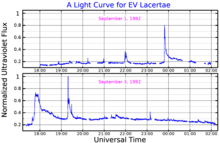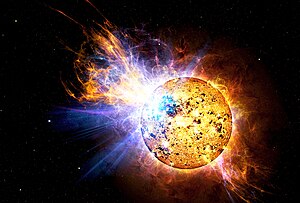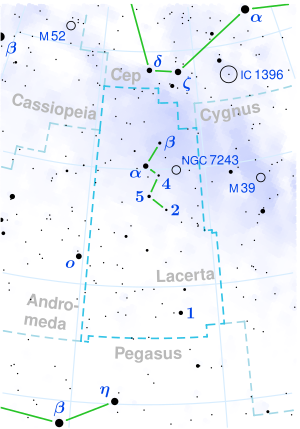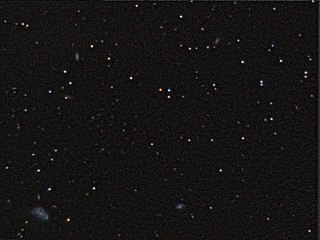
Wolf 359 is a red dwarf star located in the constellation Leo, near the ecliptic. At a distance of 7.86 light-years from Earth, it has an apparent magnitude of 13.54 and can only be seen with a large telescope. Wolf 359 is one of the nearest stars to the Sun; only the Alpha Centauri system, Barnard's Star, and the brown dwarfs Luhman 16 and WISE 0855−0714 are known to be closer. Its proximity to Earth has led to its mention in several works of fiction.
Ross 154 is a star in the southern zodiac constellation of Sagittarius. It has an apparent visual magnitude of 10.44, making it much too faint to be seen with the naked eye. At a minimum, viewing Ross 154 requires a telescope with an aperture of 6.5 cm (3 in) under ideal conditions. The distance to this star can be estimated from parallax measurements, which places it at 9.71 light-years away from Earth. It is the nearest star in the southern constellation Sagittarius, and one of the nearest stars to the Sun.
Gliese 65, also known as Luyten 726-8, is a binary star system that is one of Earth's nearest neighbors, at about 8.7 light years from Earth in the constellation Cetus. The two component stars are both flare stars with the variable star designations BL Ceti and UV Ceti.
HD 46375 is double star with an exoplanetary companion in the equatorial constellation of Monoceros. It presents as an 8th-magnitude star with an apparent visual magnitude of 7.91, which is too dim to be readily visible to the naked eye. The system is located at a distance of 96.5 light-years from the Sun based on parallax measurements, but is slowly drifting closer with a radial velocity of −1 km/s. The common proper motion stellar companion, designated HD 46375 B, has a linear projected separation of 346±13 AU.

A flare star is a variable star that can undergo unpredictable dramatic increases in brightness for a few minutes. It is believed that the flares on flare stars are analogous to solar flares in that they are due to the magnetic energy stored in the stars' atmospheres. The brightness increase is across the spectrum, from X-rays to radio waves. Flare activity among late-type stars was first reported by A. van Maanen in 1945, for WX Ursae Majoris and YZ Canis Minoris. However, the best-known flare star is UV Ceti, first observed to flare in 1948. Today similar flare stars are classified as UV Ceti type variable stars in variable star catalogs such as the General Catalogue of Variable Stars.
Struve 2398 is a binary star system in the northern constellation of Draco. Struve 2398 is star number 2398 in the Struve Double Star Catalog of Russian-German astronomer Friedrich Georg Wilhelm von Struve. The astronomer's surname, and hence the star identifier, is sometimes indicated by a Greek sigma, Σ; hence, this system can be listed with the identifier Σ 2398. Although the components are too faint to be viewed with the naked eye, this star system is among the closest to the Sun. Parallax measurements by the Gaia spacecraft give them an estimated distance of 11.5 light-years away.
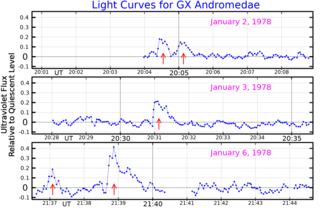
Groombridge 34 is a binary star system in the northern constellation of Andromeda. It was listed as entry number 34 in A Catalogue of Circumpolar Stars, published posthumously in 1838 by British astronomer Stephen Groombridge. Based upon parallax measurements taken by the Gaia spacecraft, the system is located about 11.6 light-years from the Sun. This positions the pair among the nearest stars to the Solar System.
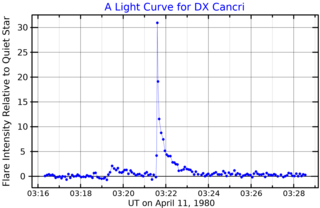
DX Cancri is a variable star in the northern zodiac constellation of Cancer. With an apparent visual magnitude of 14.81, it is much too faint to be seen with the naked eye. Visually viewing this star requires a telescope with a minimum aperture of 16 in (41 cm). Based upon parallax measurements, DX Cancri is located at a distance of 11.8 light-years from Earth. This makes it the 18th closest star to the Sun.

Lacaille 8760 is a red dwarf star in the constellation Microscopium. It is one of the nearest stars to the Sun at about 12.9 light-years' distance, and the brightest M-class main-sequence star in Earth's night sky, although it is generally too faint to be seen without a telescope. At an apparent magnitude of +6.7, it may only be visible to the unaided eye under exceptionally good viewing conditions, under dark skies.
TZ Arietis is a red dwarf in the northern constellation of Aries. With a normal apparent visual magnitude of 12.3, it is too faint to be seen by the naked eye, although it lies relatively close to the Sun at a distance of 14.6 light-years. It is a flare star, which means it can suddenly increase in brightness for short periods of time.

AD Leonis (Gliese 388) is a red dwarf star. It is located relatively near the Sun, at a distance of 16.2 light-years, in the constellation Leo. AD Leonis is a main sequence star with a spectral classification of M3.5V. It is a flare star that undergoes random increases in luminosity.
HD 50281 is a star in the equatorial constellation of Monoceros. It is orange in hue with an apparent visual magnitude of 6.58, which lies at or below the typical limit of visibility to the naked eye. The star is located at a distance of 28.5 light years from the Sun based on parallax, but is drifting closer with a radial velocity of −7.2 km/s.
Gliese 412 is a pair of stars that share a common proper motion through space and are thought to form a binary star system. The pair have an angular separation of 31.4″ at a position angle of 126.1°. They are located 15.8 light-years distant from the Sun in the constellation Ursa Major. Both components are relatively dim red dwarf stars.

EQ Virginis is a single variable star in the equatorial constellation of Virgo. It has a baseline visual apparent magnitude of 9.36, but is a flare star that undergoes sporadic bursts of brightening. The star is located at a distance of 67 light-years from the Sun based on parallax measurements, but is drifting closer with a radial velocity of −23 km/s. It is a member of the IC 2391 moving group of stars, which is between 30 and 50 million years old.
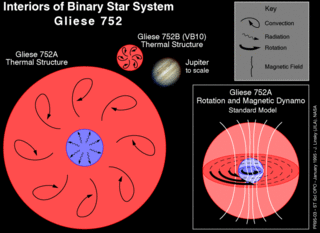
Gliese 752 is a binary star system in the Aquila constellation. This system is relatively nearby, at a distance of 19.3 light-years.
Gliese 179 is a small red dwarf star with an exoplanetary companion in the equatorial constellation of Orion. It is much too faint to be visible to the naked eye with an apparent visual magnitude of 11.94. The system is located at a distance of 40.5 light-years from the Sun based on parallax measurements, but is drifting closer with a radial velocity of –9 km/s. It is a high proper motion star, traversing the celestial sphere at an angular rate of 0.370″·yr−1.

YZ Canis Minoris is a red-hued star in the equatorial constellation of Canis Minor. With an apparent visual magnitude of 11.15, it is much too faint to be viewed with the naked eye. The distance to YZ CMi can be estimated from its annual parallax shift of 167 mas, yielding a value of 19.5 light years. Presently the star is moving further away with a heliocentric radial velocity of +26.5 km/s. It made its closest approach some 162,000 years ago when it made perihelion passage at a distance of 10.2 ly. YZ CMi is a potential member of the Beta Pictoris moving group.
Gliese 829 is a double-lined spectroscopic binary system of two red dwarf stars in the constellation of Pegasus. They have a high proper motion of 1.08 arc seconds per year along a position angle of +69.58°. Based upon parallax measurements, the stars are at a distance of about 22 light years from the Sun. The system will make its closest approach to the Sun around 91,000 years from now when it achieves a perihelion distance of 17.65 ly (5.410 pc).

V1005 Orionis is a young flare star in the equatorial constellation of Orion. It has the identifier GJ 182 in the Gliese–Jahreiß catalogue; V1005 Ori is its variable star designation. This star is too faint to be visible to the naked eye, having a mean apparent visual magnitude of 10.1. It is located at a distance of 79.6 light years from the Sun and is drifting further away with a radial velocity of 19.2 km/s. The star is a possible member of the IC 2391 supercluster.
